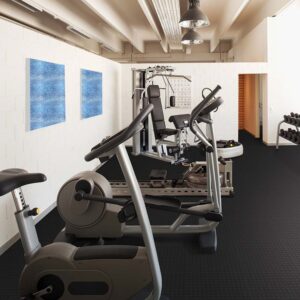A Comprehensive Guide to PVC Mats: Your Durable and Versatile Flooring Solution
Home gym flooring: How thick should flooring be

Just like commercial gym flooring, home gym flooring must also be durable enough to withstand your gym activities. Users, equipment, and subfloors must be protected at all times.
The most common home gym flooring options include but are not limited to:
- Rubber Interlocking tiles
- EVA foam
- Vinyl
- Carpet
There are several factors to consider when selecting the right thickness for your home gym floor. Type of equipment, space, goals, whether it is a permanent or temporary gym, and also activities to be done on the gym all determine the type and thickness of the floors. The gym floor should always be comfortable and able to protect the user from hard surfaces floors.
Best Flooring Thickness for Home Weight Lifting
Usually, home weight lifting equipment is not that very heavy, as many home gyms are mostly used for exercises and not for build building.
Rubber Gym flooring is ideal for this kind of activity as it is durable, resilient, and is an impact absorber. For a home gym, a 3/8” rubber thickness is appropriate as it can withstand the impact of the weights. However, there are many different thicknesses for this material that one can choose from depending on your weights and equipment.
Best Flooring Thickness for Home Aerobics
The best flooring option for such kinds of lightweight exercises is Eva Foam mats, the foam mats are available in different dimensions and thicknesses also depending on the intensity of your workouts. 20mm – 25mm thickness is a great option is it caters to various types of activities be it standing or ground workouts
Eva foam is an impact and shock absorber and can protect users from possible various injuries resulting from impacts.
There are other vital variables that contribute to the flooring thickness of your home gym flooring as discussed below:-
Gym Location
Does the area or room used as a gym have a dual purpose, is the space used for other functions? Most home gyms are garages used as gyms. So when selecting the right flooring thickness it is important to consider and understand the flooring requirements for the other activities.
Other areas are prone to moisture, so the type and thickness of the flooring option should also put into consideration.
Subfloors
Subfloors are also one of the critical factors to consider when choosing the right and best thickness of your gym flooring. The previously installed floor determines the thickness of your gym floor-covering for example a carpeted subfloor does not require a much thicker top flooring for your gym as the carpet is already protecting the subfloors.
Usage
The number of people using the home gym also determines the type and size of the flooring required for the gym. A place that is frequented by users, and the nature of activities associated with the gym determines the thickness of the flooring.
The right flooring improves user experience and also encourages the continual use of the gym. From the points discussed above, it is clear that the flooring thickness of a home gym varies, there is no one size fits all flooring option, but a single home gym can have different types of floors and different thicknesses depending on the activities happening in a particular space.
Areas, where there is heavy equipment, should have a thicker rubber flooring to protect the equipment and the subfloors from any damages resulting from any impacts, also areas used for light workouts have no need for a much thicker flooring and Eva Foam is the best flooring option for such workouts.
Despite picking the right thickness for your home gym flooring, it is important to choose a floor that is durable, easy to clean, that has low maintenance costs and is also easy to install. A home gym help saves a lot of money from gym subscriptions and also encourages everyone at home to work out.
We have a variety of home gym flooring materials, do not hesitate to get in touch with us for a free quote.
This Post Has 0 Comments